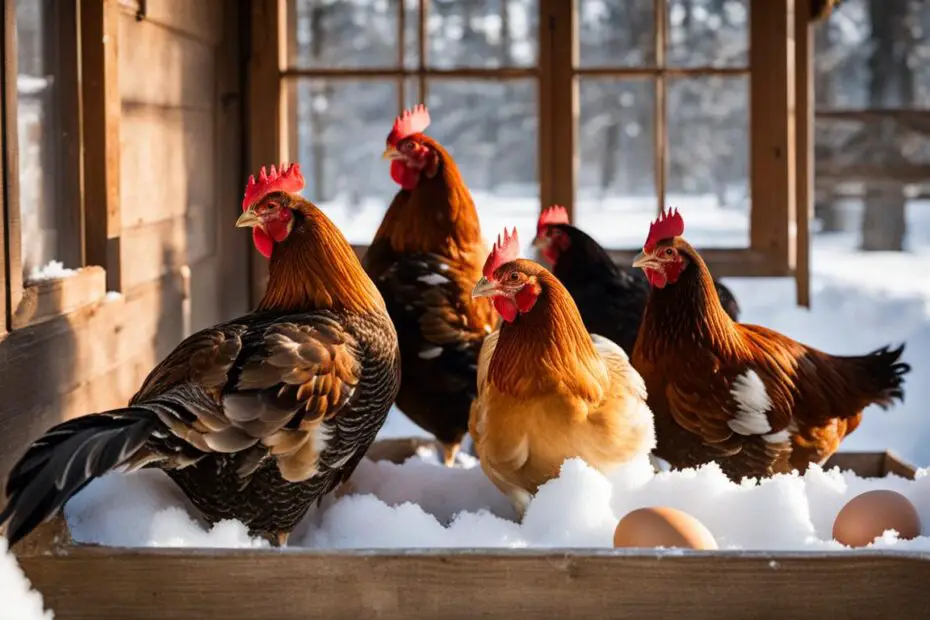As winter approaches, many chicken owners wonder if their feathered friends will continue to lay eggs during the colder months. The answer is not a simple yes or no, as various factors influence egg production in chickens during winter. Let’s explore these factors and shed some light on the topic.
Key Takeaways:
- Chickens experience a decrease in egg production during winter due to insufficient light, the fall molt, and cold temperatures in the coop.
- Ensuring hens receive at least 12-16 hours of light per day can help maintain continuous egg laying, especially for certain breeds bred for cold weather or high egg production.
- The fall molt, where hens grow new feathers, also contributes to the decrease in egg production during winter.
- Cold temperatures can cause cold stress in chickens, diverting their energy towards staying warm and resulting in a halt in egg laying.
- Strategies to maximize winter egg production include providing adequate light, water, nutrition, and ensuring the overall health of the hens.
11 Ways to Make Money by Chicken Farming
Do Chickens Lay Eggs in Winter
Reasons Why Chickens Don’t Lay Eggs in the Winter🐤
During winter, chickens experience a decrease in egg production due to several triggers. Understanding these reasons can help chicken owners manage and address the issue effectively. The three main triggers for decreased egg production in winter are insufficient light, the fall molt, and cold temperatures in the coop. do chickens lay eggs in winter
Firstly, chickens require a certain amount of light to trigger their reproductive systems. The shorter daylight hours in winter result in reduced egg laying. Secondly, the fall molt, which happens annually, requires significant energy for feather growth. This energy diversion can pause egg production during the molt. Finally, cold temperatures divert energy towards thermoregulation, reducing the hen’s ability to lay eggs.
To illustrate these triggers more clearly, here is a table summarizing the reasons why chickens don’t lay eggs in the winter:
| Reason | Description |
|---|---|
| Insufficient Light | Shorter daylight hours in winter result in reduced egg laying. |
| Fall Molt | Hens divert energy towards feather growth, pausing egg production. |
| Cold Temperatures | Energy is directed towards thermoregulation, reducing the hen’s ability to lay eggs. |
By understanding these triggers, chicken owners can implement strategies to mitigate the decrease in egg production during winter. Providing additional light in the coop, ensuring proper nutrition and water access, and maintaining flock health are some ways to support egg production in winter. Breed selection, with an emphasis on cold-hardy or high-production breeds, can also play a role in maintaining consistent winter egg laying. chickens laying eggs in winter
How Light Affects Chicken Reproduction
Light plays a crucial role in the reproductive system of chickens, and its impact on egg laying is well-documented. A hen’s pineal gland, located on her head, is highly sensitive to light and darkness, and it serves as the main trigger for her hormonal behaviors, including egg laying. In order to activate a hen’s laying cycle, her pineal gland needs to sense enough light for a sufficient duration. Typically, hens require between 12 to 16 hours of light to maintain continuous egg laying, even during the winter months.
However, it’s important to note that the exact light requirement can vary based on the age and breed of the hen. Young pullets may continue laying during the winter with less light, while certain breeds bred for cold weather or high egg production may exhibit greater tolerance for shorter daylight hours. It’s essential for chicken owners to provide adequate lighting conditions in the coop to simulate longer daylight hours and ensure that hens receive the necessary light cue for sustained egg production. winter egg laying chickens
“Light plays a crucial role in the reproductive system of chickens, and its impact on egg laying is well-documented.”
By understanding the role of light in chicken reproduction, chicken owners can better manage and support winter egg production. Supplemental lighting can be added to the coop to extend the number of daily daylight hours hens are exposed to, encouraging continuous egg laying. However, it’s important to strike a balance and not overexpose hens to excessive light, as this can disrupt their natural rhythms and lead to other health issues. Additionally, providing a consistent lighting schedule, combined with proper nutrition, water access, and flock management, can help maximize winter egg production and ensure a steady supply of eggs.
Light and Egg Production: Tips for Chicken Owners
Here are some tips for chicken owners to optimize the impact of light on egg production:
- Provide supplemental lighting in the coop to simulate longer daylight hours and trigger the hen’s reproductive system. Ensure the lighting schedule is consistent and aligned with the natural daylight cycle.
- Use bulbs specifically designed for poultry, as they emit light in the appropriate spectrum for optimal reproductive function.
- Position the lighting source at an appropriate height and angle to evenly distribute light throughout the coop and minimize shadows.
- Avoid sudden changes in lighting conditions or exposure to artificial light during natural dark periods.
- Monitor the behavior and health of the hens closely, as excessive light exposure or disruptions to their natural rhythms can have negative effects.
By implementing these strategies, chicken owners can effectively leverage the role of light in chicken reproduction, supporting optimal egg production throughout the year. chickens and winter egg production
The Impact of the Fall Molt on Egg Production
The fall molt, an annual shedding of feathers, can significantly impact egg production in chickens during winter. During this period, hens replace their old, worn feathers with new ones, which requires a substantial amount of energy. As a result, the hen’s body redirects its resources towards feather growth, reducing the energy available for egg production. The combination of feather molting and shorter daylight hours in the fall can lead to a pause in egg laying as the hen’s reproductive system prioritizes feather growth.winter egg production in chickens
The timing and duration of the fall molt can vary among individual hens and are influenced by factors such as breed, age, and environmental conditions. Some hens may start molting earlier in the season, while others may molt later. The molt typically lasts for several weeks to a couple of months, during which the hen’s egg production can significantly decrease or even cease entirely. do hens lay eggs in the winter
It’s important for chicken owners to recognize the signs of molting in their hens, as it can help explain the decline in egg production during winter. One common indicator is the appearance of new feathers, especially in the tail area. As the molting process progresses, the old feathers are gradually replaced by new ones, signaling that the hen is nearing the end of the molt and may soon resume laying eggs. Patience and proper care, including providing a balanced diet and ensuring a stress-free environment, can help support hens through the molt and ultimately improve winter egg production.
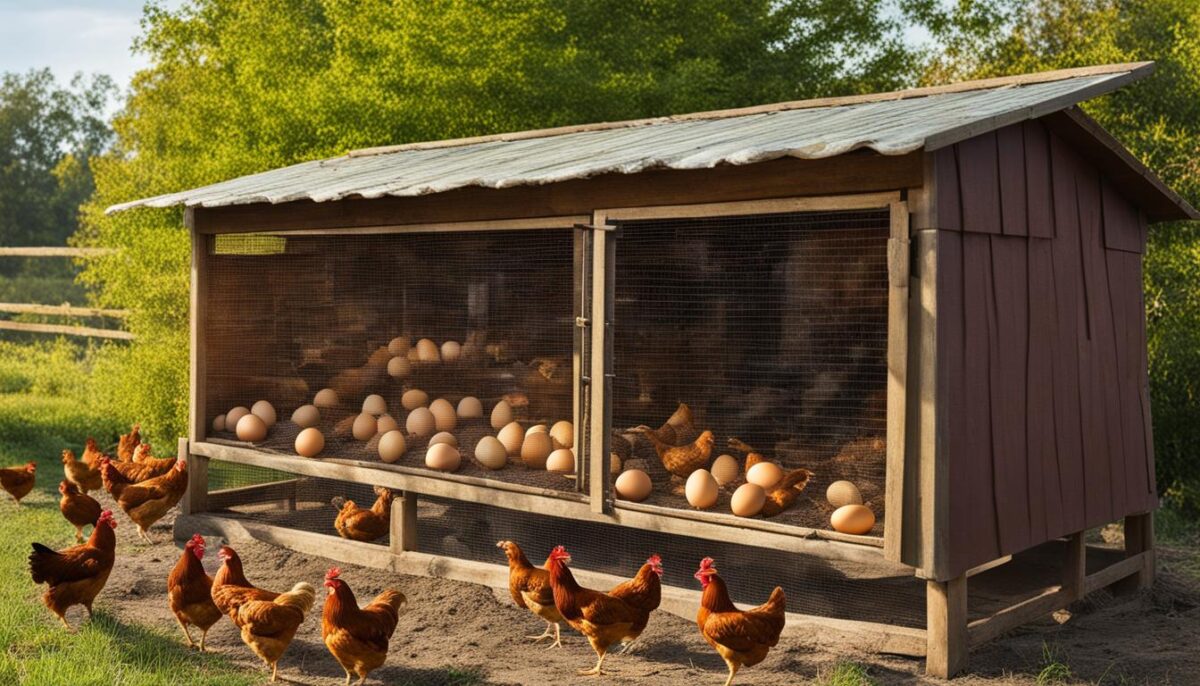
The Impact of the Fall Molt on Egg Production
| Key Factors | Impact on Egg Production |
|---|---|
| Feather Growth | High energy requirement diverts resources away from egg production. |
| Shorter Daylight Hours | Reproductive system prioritizes feather growth over egg laying. |
| Varying Timing and Duration | Individual hens molt at different times, leading to fluctuations in egg production. |
| Molt Indicators | Presence of new feathers, particularly in the tail area, signals the nearing end of the molt. |
Understanding the impact of the fall molt on egg production is key to managing winter egg laying in chickens. By recognizing the natural process of molting and providing the necessary care and nutrition, chicken owners can support their hens through this phase and optimize egg production during the winter months. w to encourage egg laying in winter
The Effect of Cold Weather on Egg Production
Cold weather has a significant impact on egg production in chickens. When exposed to severe winter temperatures, chickens may cease or decrease their egg laying due to the energy required to stay warm and maintain overall well-being. Cold stress occurs when chickens endure prolonged exposure to low temperatures, which can negatively affect their health and productivity. Older hens are more sensitive to cold stress and may stop laying eggs earlier than younger hens. how to encourage egg laying in winter
In cold weather, chickens divert their energy towards thermoregulation, which reduces their ability to lay eggs. This energy diversion is necessary for the hens to maintain their body temperature and survive the harsh conditions. Their reproductive system takes a backseat as their primary focus becomes staying warm. Cold stress can also lead to decreased appetite and overall health issues, further impacting egg production.
“Severe winter weather can cause chickens to cease egg laying due to the energy requirements for thermoregulation and overall well-being.”
However, it’s important to note that some chicken breeds are better adapted to cold temperatures and can continue laying eggs during winter. These cold-hardy breeds have developed physiological and behavioral mechanisms to withstand low temperatures. They can maintain adequate body heat and allocate energy towards egg production despite the cold weather. Additionally, hens that have had ample time to acclimate to colder temperatures are more likely to sustain egg production. chickens and cold weather egg laying
Table: Cold-Hardy Chicken Breeds
| Breed | Adaptability to Cold Weather | Ability to Lay Eggs in Winter |
|---|---|---|
| Rhode Island Red | High | Yes |
| Wyandotte | High | Yes |
| Plymouth Rock | High | Yes |
| Buff Orpington | Medium | Yes |
| Delaware | Medium | Yes |
It’s worth noting that the ability to lay eggs during winter also depends on other factors, such as proper nutrition, access to fresh water, and overall flock health. Providing a well-balanced diet, ensuring clean drinking water, and implementing good flock management practices are essential in supporting egg production, especially in cold weather conditions. maximizing egg production in winter chickens
Chicken Breeds and Winter Egg Production
When it comes to winter egg production, the choice of chicken breeds can make a significant difference. Some breeds are naturally more cold hardy and better suited for laying eggs during the colder months. These breeds have been selectively bred for their ability to withstand low temperatures, adapt to shorter daylight hours, and continue producing eggs throughout the winter season.
One example of a cold hardy breed is the Rhode Island Red. Known for their robustness and adaptability, Rhode Island Reds can maintain consistent egg laying even in cold weather. Another breed that excels in winter egg production is the Wyandotte. With their thick feathering and well-insulated bodies, Wyandottes are well-equipped to handle colder temperatures and continue laying eggs.
For those looking for high egg production during winter, breeds like the White Leghorn and the Red Star can be excellent choices. These breeds have been bred specifically for their ability to produce a large number of eggs throughout the year, including the winter months. They are efficient layers and can often continue laying even in less ideal conditions.
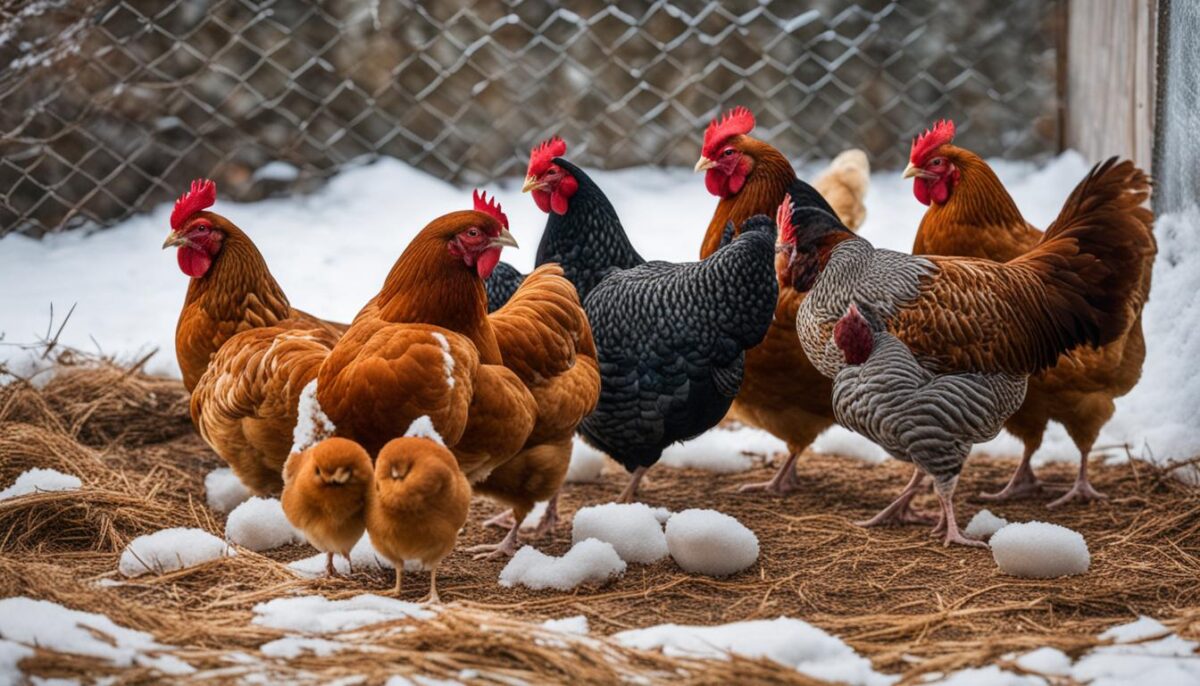
Breed Comparison for Winter Egg Production
| Breed | Cold Hardy | Egg Production |
|---|---|---|
| Rhode Island Red | Yes | Good |
| Wyandotte | Yes | Moderate |
| White Leghorn | No | Excellent |
| Red Star | No | Excellent |
“Choosing the right chicken breeds for winter egg production is crucial in ensuring a steady supply of eggs during the colder months. If you live in an area with harsh winters, cold hardy breeds like the Rhode Island Red and Wyandotte are ideal choices. However, if high egg production is your priority, breeds like the White Leghorn and Red Star can be excellent options. Consider your climate and egg production goals when selecting chicken breeds for winter egg laying.”
By carefully selecting the appropriate chicken breeds for winter egg production, poultry keepers can enjoy a continuous supply of fresh eggs throughout the year. Whether you prioritize cold hardiness or high egg production, there are breeds available that can meet your specific needs. It’s important to consider factors such as your local climate, the amount of daylight hours available, and the overall health and well-being of the chickens when planning for winter egg production. With the right breeds and proper care, you can enjoy the rewards of winter egg-laying chickens.
Tips for Maximizing Winter Egg Production
To ensure maximum egg production during the winter months, there are several strategies that can be implemented. By following these tips, you can encourage your hens to continue laying eggs even in colder weather.
Provide Adequate Lighting
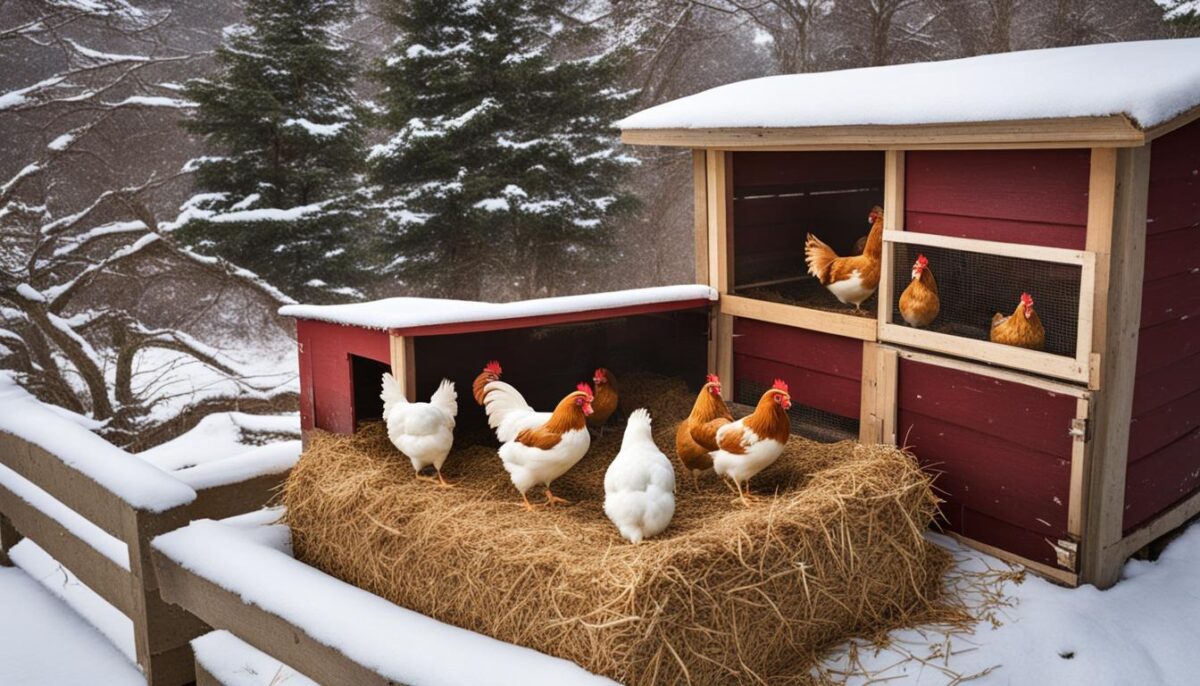
“Chickens require a certain amount of light to trigger their reproductive systems.”
One key factor in supporting winter egg production is providing additional light in the chicken coop. This can help simulate longer daylight hours and encourage hens to continue laying. By adding artificial lighting and ensuring hens receive at least 14-16 hours of light per day, you can help maintain consistent egg production even during the darker winter months.
Focus on Nutrition
“Offering nutritionally balanced feed, including adequate protein and supplemental calcium, is crucial for optimal egg production.”
Proper nutrition is essential for optimal egg production. Make sure your hens have access to a nutritionally balanced feed that is rich in protein and contains supplemental calcium. Protein is important for egg development, while calcium ensures the formation of strong eggshells. Providing a well-balanced diet will help support your hens’ overall health and maximize their egg-laying potential.
Ensure Flock Health
“Proper care and management, such as maintaining flock health and protecting against cold stress, are essential for supporting winter egg production.”
Keeping your flock healthy is crucial for maximizing winter egg production. Regularly check your hens for any signs of illness or injury and address any issues promptly. Protecting your hens from cold stress is also important. Ensure they have a well-insulated coop, with proper ventilation to prevent moisture buildup. Providing access to fresh, unfrozen water is vital as well.
Consider Staggering the Ages of Your Flock
“Staggering the ages of your flock can ensure a steady supply of eggs year-round.”
If possible, consider adding new chicks to your flock each year. Younger hens typically do not molt during their first year, so they will continue laying throughout the winter months. By introducing new chicks annually, you can maintain a steady supply of eggs even when older hens may naturally decrease or pause egg production.
| Tips for Maximizing Winter Egg Production |
|---|
| Provide Adequate Lighting |
| Focus on Nutrition |
| Ensure Flock Health |
| Consider Staggering the Ages of Your Flock |
Breeds That Lay Eggs Throughout Winter
While many chicken breeds experience a decrease in egg production during winter, there are certain breeds known for their ability to consistently lay eggs throughout the colder months. These breeds, often referred to as winter egg-laying breeds or consistent winter layers, have specific characteristics and adaptations that make them more resilient to cold weather and reduced daylight hours. By incorporating these breeds into your flock, you can increase the likelihood of continuous egg production during winter.
Here are some popular chicken breeds that are known for their ability to lay eggs throughout winter:
| Breed | Egg Color | Size | Winter Egg Production |
|---|---|---|---|
| Whiting True Green | Green | Medium | High |
| Wyandottes | Brown | Large | High |
| Orpingtons | Brown | Large | Medium |
| Rhode Island Reds | Brown | Large | High |
| Red Star | Brown | Large | High |
These breeds have been selectively bred for their ability to lay eggs consistently, even in colder temperatures and shorter daylight hours. They have adaptations that allow them to adjust to the challenges of winter and maintain their egg-laying capability. By choosing these breeds, you can enjoy a steady supply of fresh eggs throughout the winter season.
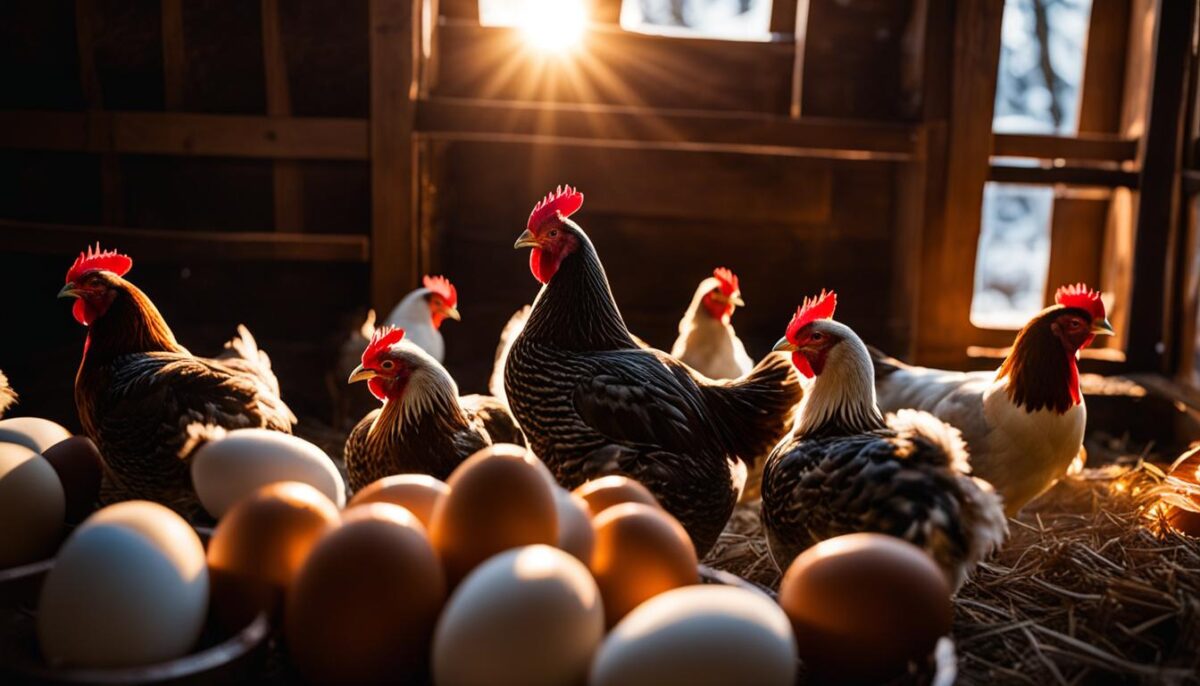
By providing at least 14-16 hours of light per day through artificial lighting, hens receive the signal they need to continue laying eggs. This practice can help maintain a more reliable supply of eggs during winter and ensure a steady source of nutrition. It is important to note that supplemental lighting is optional and should be combined with other factors like proper nutrition, water access, and flock management to support optimal egg production.
Adding light to the chicken coop can be achieved through various methods. LED lights are energy-efficient and provide consistent lighting. Timers can also be used to automate the lighting schedule and ensure a consistent duration of light exposure. However, it is crucial to monitor the temperature in the coop, as excessive heat from the lights can be detrimental to the chickens’ health.
Conclusion
In conclusion, maximizing winter egg production and maintaining a year-round egg supply requires understanding the factors that impact egg laying during colder months. Chickens naturally reduce or pause egg production in response to insufficient light, the fall molt, and cold stress. However, by implementing effective strategies, such as providing additional light, ensuring proper nutrition and water access, and maintaining flock health, it is possible to sustain egg production during winter.
One key strategy is to add supplemental light to the chicken coop, simulating longer daylight hours and triggering the hen’s reproductive system. By providing at least 14-16 hours of light per day through artificial lighting, hens receive the necessary light cue for continuous laying. This practice, when combined with other factors like proper nutrition and flock management, can help ensure a more reliable supply of eggs throughout winter.
Furthermore, breed selection plays a significant role in winter egg production. Cold-hardy breeds, specifically bred for cold weather conditions, as well as high-production breeds, are more likely to lay eggs during winter. By keeping a variety of these breeds in your flock, you increase the chances of consistent egg production throughout the colder months.
By understanding the factors affecting winter egg production and employing suitable strategies, chicken owners can maximize egg production, maintain a year-round egg supply, and enjoy a consistent source of fresh eggs even during the winter season.
FAQ
Do chickens lay eggs in the winter?
Chickens may experience a decrease in egg production during winter, but certain factors can influence their ability to lay eggs consistently.
What are the reasons why chickens don’t lay eggs in the winter?
Chickens may stop laying eggs in winter due to insufficient light, the fall molt, and cold temperatures in the coop.
How does light affect chicken reproduction?
The amount of light a hen receives affects her reproductive system. Hens need at least 12-16 hours of light for continuous egg laying during winter.
What is the impact of the fall molt on egg production?
During the fall molt, hens focus on growing new feathers, which requires significant energy. This can lead to a pause in egg laying during winter.
How does cold weather affect egg production?
Cold temperatures can divert energy towards thermoregulation, reducing a hen’s ability to lay eggs. Cold stress can also negatively impact a hen’s health and productivity.
Do chicken breeds play a role in winter egg production?
Yes, certain chicken breeds bred for cold weather or high egg production may lay throughout the winter months. Cold hardy breeds are more likely to lay eggs during winter.
What are some tips for maximizing winter egg production?
Providing adequate light, water, nutrition, and ensuring the hens are healthy can help mitigate the decrease in egg production during winter.
Are there specific breeds that lay eggs throughout winter?
Yes, breeds such as Whiting True Green, Wyandottes, Orpingtons, Rhode Island Reds, and Red Star are known for their ability to lay eggs during winter.
How important is light in winter egg production?
Supplemental light in the chicken coop can help maintain consistent egg laying by simulating longer daylight hours and triggering the hen’s reproductive system.
Is it possible to have a reliable supply of eggs during winter?
With proper care, management, and the implementation of strategies, it is possible to have a more reliable supply of eggs throughout the winter season.


